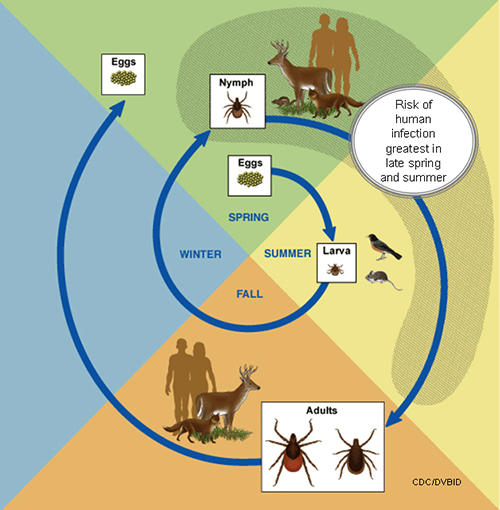Tick-borne encephalitis causes
|
Tick-borne encephalitis Microchapters |
|
Diagnosis |
|---|
|
Treatment |
|
Case Studies |
|
Tick-borne encephalitis causes On the Web |
|
American Roentgen Ray Society Images of Tick-borne encephalitis causes |
|
Risk calculators and risk factors for Tick-borne encephalitis causes |
Editor-In-Chief: C. Michael Gibson, M.S., M.D. [1] Associate Editor(s)-in-Chief: Ilan Dock, B.S.
Overview
Tick-borne diseases are most often transmitted during a blood meal, either by a nymph of adult tick. Blood meals will occur with a higher rate of incidence from the late spring into the early fall, with the highest rate of tick-borne encephalitis viral (TBEV) infections during the early and late summer. The primary disease vector for TBEV is the Ixodidae tick family, found throughout most of Eurasia. The virus itself is a member of the flavivirus genus, with three distinct subtypes. The virus is a (+) ssRNA genome enclosed in a capsid protein. It begins by locating a host cell receptor. The virus is internalized through the process of endocytosis. During this time the virus hi-jacks the host cells replication machinery, in order to replicate many times within the host cell. Upon completion the cell releases many immature virions for further progression of the disease.
Life Cycle and Spread of Tick-Borne Diseases

General Tick Life Cycle [1]
- A tick's life cycle is composed of four stages: hatching (egg), nymph (six legged), nymph (eight legged), and an adult.
- Ticks require blood meal to survive through their life cycle.
- Hosts for tick blood meals include mammals, birds, reptiles, and amphibians. Ticks will most likely transfer between different hosts during the different stages of their life cycle.
- Humans are most often targeted during the nymph and adult stages of the life cycle.
- Life cycle is also dependent on seasonal variation.
- Ticks will go from eggs to larva during the summer months, infecting bird or rodent host during the larval stage.
- Larva will infect the host from the summer until the following spring, at which point they will progress into the nymph stage.
- During the nymph stage, a tick will most likely seek a mammal host (including humans).
- A nymph will remain with the selected host until the following fall at which point it will progress into an adult.
- As an adult, a tick will feed on a mammalian host. However unlike previous stages, ticks will prefer larger mammals over rodents.
- The average tick life cycle requires three years for completion.
- Different species will undergo certain variations within their individual life cycles.
Spread of Tick-borne Diseases
- Ticks require blood meals in order to progress through their life cycles.
- The average tick requires 10 minutes to 2 hours when preparing a blood meal.
- Once feeding, releases anesthetic properties into its host, via its saliva.
- A feeding tube enters the host followed by an adhesive-like substance, attaching the tick to the host during the blood meal.
- A tick will feed for several days, feeding on the host blood and ingesting the host's pathogens.
- Once feeding is completed, the tick will seek a new host and transfer any pathogens during the next feeding process. [1]
Transmission
- The Ixodidae family of hard ticks have been reported as the vector and reservoir of the Tick-borne encephalitis virus.
- Other modes of transmission include the consumption of raw milk as well as vertical transmission from mother to fetus.
Virology
- Member of the Falvivirus genus
- Flaviviridae family
- Three subtypes: Far East, European, and Siberian
- Viral strains are mostly homogeneous within infected European tick populations.
- Diversity exists within viral strains carried by Siberian and Far Eastern tick populations. Thus these populations host antigenic variations and a variety of subtypes.
- However the antigenic similarity within these populations allows for a generalized protection method among the different subtypes.
Genomics
- (+)ssRNA genome enclosed in a capsid protein.
- Genome is protected by a lipid bilayer, provided by the host or target cell.
- Virus's physical attributes include a spherical particle with an approximate diameter of 50-60nm.
- The genome lacks a 3'-poly(A) tail, yet provides a 5' cap.
- In terms of length, the genome spans an average of 11kb.
References
- ↑ 1.0 1.1 Life Cycle of Ticks that Bite Humans (2015). http://www.cdc.gov/ticks/life_cycle_and_hosts.html Accessed on December 30, 2015